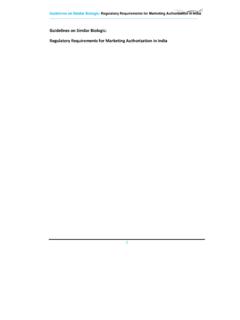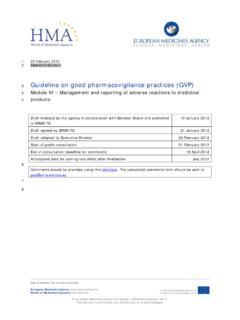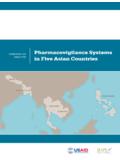Transcription of WHO Drug Information
1 573 WHO Drug Information Vol. 31, No. 4, 2017 ContentsSafety of medicines575 Priming resource-limited countries for pharmacovigilanceNaming of medicines581 Survey about International Nonproprietary Names (INN)Safety news586 Safety warningsMiconazole oral gel ; Obeticholic acid ; Linagliptine ; Dabigatran ; Flucloxacillin ; Epoetins ; Intraocular vancomycin ; Fingolimod ; Daclizumab ; Levetiracetam ; Sodium polystyrene sulfonate ; Radium-223 dichloride 590 Known risksAmoxicillin ; Moxifloxacin ; Palivizumab ; Cladribine ; Clozapine ; Buprenorphine, methadone 591 Review outcomesFactor VIII medicines592 Reviews startedHydroxyethyl starch;Ulipristal ;Febuxostat;Flupirtine-containing products;Radium-223 593 Non-compliance with good practicesLupin Falsified medicinesFalsified Penicillin V circulating in CameroonRegulatory news594 Pre-market assessmentChina: Regulatory reforms ; : Promoting competition for complex products ;Europe: Regulators and funders meet.
2 Australia: Parallel submissions;EU: Access to clinical data ;Third tripartite meeting on evaluation of antibiotics;EU: Ten years of paediatric regulation 596 Post-market monitoring Operation Pangea X;Smart Safety Surveillance in LMICs; : New adverse event dashboard ;Australia: Black triangle scheme ;EU: Updated pharmacovigilance guidelines ;EU: Improved Eudravigilance system launched597 VariationsAustralia: Automated notifications597 : Antimicrobials;EU: Excipients ;Canada: Prescription opioids598 Product-specific frameworksCanada: Antimicrobials;EU: Advanced therapies ; : Regenerative medicine products;Australia: Autologous products 599 Medical devicesIndia: Classification list;UK: Guide to new EU requirements 600 CollaborationEU-FDA mutual recognition agreement on inspections;Singapore joins ICH;IGDRP and IPRF merge;Regulatory summit and ICMRA meeting;Generic work-sharing trial601 Under discussion603 ApprovedSemaglutide; Vestronidase alfa ; Rurioctocog alfa pegol ; Emicizumab ; Non-live recombinant zoster vaccine ; Padeliporfin ; Dolutegravir and rilpivirine ; Letermovir ; Copanlisib ; Abemaciclib ; Acalabrutinib ; Benralizumab ; Latanoprostene bunod Gene cell therapyAxicabtagene ciloleucel BiosimilarsInsulin lispro; Trastuzumab; Bevacizumab; Filgrastim (South Africa) ; AdelimumabNovel dosage formsOrodispersible budesonide ; Aripiprazole with tracking sensor; Once-monthly buprenorphine Extensions of indicationsSunitinib ; Vemurafenib ; Mepolizumab DiagnosticsNext-generation sequencing (NGS) cancer profiling testsContinuedWHO Drug Information574 WHO Drug Information Vol.
3 31, No. 4, 2017 Publications and events609 Access to medicinesHepatitis C medicines landscape;MPP licence for bictegravir;New methodologies for Access to Medicine Index610 Safety and efficacy of medicinesExpedited approval and label changes;Real-world data may support new indications610 Medicines qualityOne in ten medical product in developing countries is substandard or falsified;Quality of cardiac drugs in Africa;Survey of antimalarials in Myanmar611 Public health updatesAntibiotic resistance ; Non-communicable diseases ; Tuberculosis; Hepatitis; Polio; Cholera ; Plague; Marburg virusYellow fever;Diphtheria618 WHO updatesPrequalification;New essential medicines lists online;Outcomes of programme review ;Framework for action against antimicrobial resistance;WHO guidance on medicines qualityConsultation documents622 The International Pharmacopoeia 622 Pyrimethamine626 Pyrimethamine tabletsATC/DDD classification629 ATC/DDD classification (temporary)633 ATC/DDD classification (final)International Nonproprietary Names (INN)635 Proposed INN.
4 List 118 ContinuedAbbreviations and websitesCHMP Committee for Medicinal Products for Human Use (EMA)EMA European Medicines Agency ( )EU European UnionFDA Food and Drug Administration ( )Health Canada Federal department responsible for health product regulation in Canada ( )HPRA Health Products Regulatory Authority, Ireland ( )HSA Health Sciences Authority, Singapore ( )ICH International Council for Harmonisation of Technical Requirements for Pharmaceuticals for Human Use ( )IGDRP International Generic Drug Regulators Programme ( )MHLW Ministry of Health, Labour and Welfare, JapanMHRA Medicines and Healthcare Products Regulatory Agency, United Kingdom ( )Medsafe New Zealand Medicines and Medical Devices Safety Authority ( )Ph. Int The International Pharmacopoeia ( )PRAC pharmacovigilance Risk Assessment Committee (EMA)PMDA Pharmaceuticals and Medical Devices Agency, Japan ( )Swissmedic Swiss Agency for Therapeutic Products ( )TGA Therapeutic Goods Administration, Australia ( ) United States of America WHO World Health Organization ( )WHO EMP WHO Essential medicines and health products ( )WHO PQT WHO Prequalification team ( )Note:The online version of this issue (freely available at ) has direct clickable hyperlinks to the documents and websites referenced.
5 575 WHO Drug Information Vol. 31, No. 4, 2017 Safety of medicinesPriming resource-limited countries for pharmacovigilance Project 3-S : Smart Safety Surveillance for priority medical productsAccess to medicines and vaccines in low- and middle-income countries (LMICs) has improved in the past two decades. However there has not been a proportionate improvement in pharmacovigilance infrastructure and activities to monitor adverse events and address safety issues. This is of particular concern as there is a sizeable pipeline of novel products to be introduced in LMICs. These products are developed in well-resourced settings, with baseline safety data that may not be entirely applicable to the population and context of target monitoring of medicines is essential to protect people from harm. The lack of functional pharmacovigilance structures could become a barrier to the introduction of these products to some LMICs and could seriously undermine the treatment options available to patients.
6 A new project proposes to strengthen pharmacovigilance capacity in LMICs and, in the long-term, establish end-to-end safety surveillance of products from their clinical development to the post-market stages. In its current phase the project focuses on selected medicines and vaccines that will be introduced in the next few years. Safety monitoring of medicinesAlthough rigorous clinical trials are conducted during medicines development, a complete set of safety data only becomes known once a product has been on the market for a long time. Continued safety monitoring in real world settings, where medicines are used together with other products, among different patient populations and in patients with multiple illnesses, is therefore critically important. At the global level, pharmacovigilance is conducted through the WHO Programme for International Drug Monitoring. Data are collected in VigiBase, the WHO global pharmacovigilance database of adverse events.
7 Set up nearly five decades ago, this database is managed and maintained by the WHO Collaborating Centre in Sweden, also known as the Uppsala Monitoring Centre (UMC). Participation by WHO Member States has increased steadily, and as of November 2017, VigiBase has received more than 16 million individual case safety reports from 127 countries worldwide. The VigiBase data comply with the highest Priming resource-limited countries for pharmacovigilanceThis article is based on Information contributed by the WHO Safety and Vigilance (SAV) Team and the Bill & Melinda Gates Foundation, with Monika Zweygarth as editor. WHO Drug Information Vol. 31, No. 4, 2017576 scientific and ethical standards including those developed by WHO, the International Council of Harmonization (ICH) and Council for International Organizations of Medical Sciences (CIOMS) and are analyzed using sophisticated statistical methods to detect signals of possible adverse effects that are not yet known.
8 However, the capacity for pharmaco vigilance is unevenly distributed among WHO Member States. While mature regulatory authorities have the relevant infrastructure and capacity to monitor medicines safety in line with international standards, this is not the case in most LMICs. Challenges in LMICsWeak regulatory systemsAlthough pharmacovigilance programmes have been created in many resource limited countries since the 1990s they remain understaffed, underfunded and often without strong legal or regulatory provisions.(1) Data from WHO and its collaborating centres suggest that only about one third of sub Saharan African countries meet the WHO defined minimum pharmaco vigilance requirements,(2) and many lack a standardized data management system. As there is limited enforcement and awareness of pharmacovigilance in LMICs, few reports are made by health care providers and patients, and most of them lack clinically important Information that could support causality assessment.
9 And on the part of industry there is often little emphasis on local risk management plans in developing markets, given the limited pharmacovigilance requirements.(3) As a result of these weaknesses, there is substantial underreporting of suspected adverse events in LMICs, and very few regulatory decisions on medicines safety in LMICs are based on local data.(4) These shortcomings are also reflected in the reports made to VigiBase: Sub Saharan African countries contribute less than 1% of all individual case safety reports (ICSR). Priming resource-limited countries for pharmacovigilanceBox 1: Project Triple-S Core approachesPilot products: Adopt a stepwise approach with an initial pilot for three new products (two medicines and one vaccine)Holistic country plan: Develop a holistic plan for pharmacovigilance as part of medicines regulation in the defined countriesLeverage available resources from partners: WHO International Drug Monitoring Programme, Global Vaccine Safety Initiative, Uppsala Monitoring Centre and other WHO collaborating centres, national pharmacovigilance centres and othersCollaboration: Liaise with other ongoing initiatives, such as the African Medicines Regulatory Harmonization (AMRH) initiativeIndustry partnership: Develop integrated plans that include key marketing authorization holdersProgressive development: Build pharmacovigilance infrastructure progressively, moving from minimum to mid-range and advanced capacity.
10 577 WHO Drug Information Vol. 31, No. 4, 2017 Complex health care systemsIn most resource limited countries the public and private health care systems are complemented by donor funded public health programmes to fight high burden diseases such as HIV, tuberculosis and malaria, to address neglected diseases, or to increase immunization coverage. Medical products dispensed in these programmes often account for the majority of pharmaceuticals used in resource limited settings. They are often approved through fast track mechanisms and scaled up rapidly, despite little experience with their safety in target countries. The pharmacovigilance needs in the treatment of specific diseases have provided an opportunity to introduce pharmacovigilance systems into additional resource limited countries. Between 2000 and 2010 the number of sub Saharan African countries with functional pharmacovigilance centres increased from less than 10 to well over 20.














